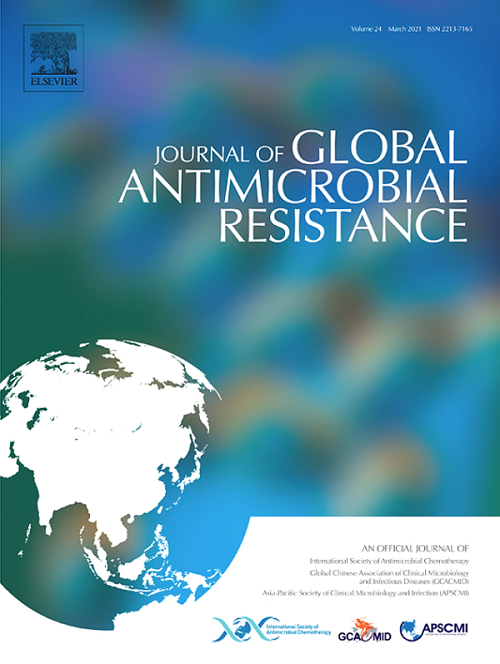Relationship between pneumococcal serotypes and antimicrobial resistance: A systematic review and meta-analysis
IF 3.2
3区 医学
Q2 INFECTIOUS DISEASES
引用次数: 0
Abstract
Background
The diversity of pneumococcal serotypes poses significant challenges for both vaccination and treatment. Clinical management of pneumococcal infections is further complicated by the fact that individual serotypes exhibit distinct antimicrobial resistance patterns. This study aims to comprehensively estimate the antimicrobial resistance rates of pneumococcal serotypes.
Methods
A comprehensive search was conducted in PubMed, Scopus, Web of Science, and ScienceDirect. A random-effect meta-analysis was used to pool the number of isolates resistant to a particular antimicrobial per total number of isolates tested for each pneumococcal serotype.
Results
Ninety studies were included in the analysis. The study identified 66 pneumococcal serotypes, with vaccine serotypes such as 19A, 19F, 23F, 6B, 14, 6A, 3, and 9V being the most frequently reported. Non-vaccine serotypes like 15A, 6C, 23A, 23B, 15B, and 35B were also prevalent. Most serotypes were associated with pneumococcal diseases. Serotypes exhibited varying and high resistance to cefuroxime, co-trimoxazole, tetracycline, macrolides, and clindamycin. The highest multidrug resistance was observed in serotypes 23F (63.34%, 95% CI [25.77; 94.31]), 15C (61.04%, 95% CI [0.74; 100.00]), 23A (57.28%, 95% CI [27.60; 84.58]), 19F (55.95%, 95% CI [30.26; 80.22]), 19A (54.07%, 95% CI [32.60; 74.90]), 15B (47.10%, 95% CI [9.66; 86.41]), 24F (45.77%, 95% CI [3.79; 91.31]), 15A (44.28%, 95% CI [29.58; 59.26]), and 6B (43.79%, 95% CI [28.48; 59.12]).
Conclusions
This study highlights significant antimicrobial resistance among both vaccine (19A, 19F, 23F, 14, 6A, and 6B) and non-vaccine types (15A, 6C, 23A, 20, 15C, and 35B). Our findings emphasize the need for effective surveillance and targeted interventions to fight these resistant pneumococcal serotypes.
肺炎球菌血清型与抗菌药物耐药性的关系:一项系统综述和荟萃分析。
背景:肺炎球菌的多种血清型使疫苗接种和治疗具有挑战性。治疗并发症是不同血清型表现出不同耐药率的结果。本研究旨在综合估计肺炎球菌血清型的抗菌素耐药率。方法:综合检索PubMed、Scopus、Web of Science、ScienceDirect。随机效应荟萃分析用于汇总每种肺炎球菌血清型检测的分离株总数中对特定抗菌素耐药的分离株数量。结果:90项研究被纳入分析。该研究确定了66种肺炎球菌血清型,其中最常报告的疫苗血清型包括19A、19F、23F、6B、14、6A、3和9V。非疫苗血清型如15A、6C、23A、23B、15B和35B也很普遍。大多数血清型与肺炎球菌疾病相关。血清型对头孢呋辛、复方新诺明、四环素、大环内酯类和克林霉素表现出不同程度的高耐药性。血清型23F为多药耐药最高(63.34%,95% CI [25.77;94.31]), 15c (61.04%, 95% ci [0.74;100.00]), 23a (57.28%, 95% ci [27.60;[84.58]), 19f (55.95%, 95% ci [30.26;80.22]), 19a (54.07%, 95% ci [32.60;74.90]), 15b (47.10%, 95% ci [9.66;86.41]), 24f (45.77%, 95% ci [3.79;91.31]), 15a (44.28%, 95% ci [29.58;59.26]), 6B (43.79%, 95% CI [28.48;59.12])。结论:本研究强调疫苗(19A、19F、23F、14、6A和6B)和非疫苗类型(15A、6C、23A、20、15C和35B)均存在显著的抗微生物药物耐药性。我们的研究结果强调需要有效的监测和有针对性的干预措施来对抗这些耐药肺炎球菌血清型。
本文章由计算机程序翻译,如有差异,请以英文原文为准。
求助全文
约1分钟内获得全文
求助全文
来源期刊

Journal of global antimicrobial resistance
INFECTIOUS DISEASES-PHARMACOLOGY & PHARMACY
CiteScore
8.70
自引率
2.20%
发文量
285
审稿时长
34 weeks
期刊介绍:
The Journal of Global Antimicrobial Resistance (JGAR) is a quarterly online journal run by an international Editorial Board that focuses on the global spread of antibiotic-resistant microbes.
JGAR is a dedicated journal for all professionals working in research, health care, the environment and animal infection control, aiming to track the resistance threat worldwide and provides a single voice devoted to antimicrobial resistance (AMR).
Featuring peer-reviewed and up to date research articles, reviews, short notes and hot topics JGAR covers the key topics related to antibacterial, antiviral, antifungal and antiparasitic resistance.
 求助内容:
求助内容: 应助结果提醒方式:
应助结果提醒方式:


